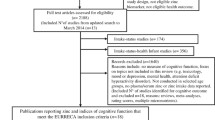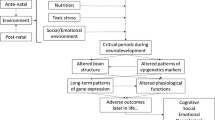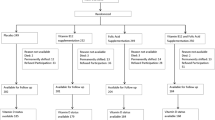Abstract
It is widely accepted that the rapid rate of growth of the brain during the last third of gestation and the early postnatal stage makes it vulnerable to an inadequate diet, although brain development continues into adulthood and micronutrient status can influence functioning beyond infancy. A deficiency of various micro-nutrients in developing countries has been found to have long-term implication for cognitive development. Vitamin A plays a critical role in visual perception and a deficiency is the leading cause of childhood blindness. A lack of iodine during a critical period in brain development is associated with reduced intellectual ability. Iron shortage is a widespread problem in the developing world but also in industrialized countries. There is evidence that iron deficiency in early life adversely effects brain development. In addition in industrialized countries a role for folate in the prevention of neural tube defects is well established and in a few individuals impaired cognitive functioning is associated with the inadequate provision of vitamin B12. The controversial suggestions that sub-clinical deficiencies of micronutrients may in industrialized societies influence anti-social behavior and intelligence are also discussed.
Similar content being viewed by others
References
Akinci A, Sarac K, Gungor S, Mungan I, Aydin O (2006) Brain MR spectroscopy findings in neonates with hypothyroidism born to mothers living in iodine-deficient areas. Am J Neuroradiol 27:2083–2087
Al-Tahan J, González-Gross M, Pietrzik K (2006) B-vitamin status and intake in European adolescents. A review of the literature. Nutr Hosp 21:452–465
American Academy of Pediatrics Committee on Nutrition (1980) Vitamin and mineral supplement needs of normal children in the United States. Pediatrics 66:1015–1020
American Dietetic Association, Dieticians of Canada: Vegetarian diets (2003). J Am Diet Assoc 103:748–765
Arnold LE, Bozzolo H, Hollway J, Cook A, DiSilvestro RA, Bozzolo DR, Crowl L, Ramadan Y, Williams C (2005) Serum zinc correlates with parent- and teacher- rated inattention in children with attention-deficit/hyperactivity disorder. J Child Adolesc Psychopharmacol 15:628–636
Arnold LE, DiSilvestro RA (2005) Zinc in attention-deficit/hyperactivity disorder. J Child Adolesc Psychopharmacol 15:619–627
Aukett MA, Parks YA, Scott PH, Wharton BA (1986) Treatment with iron increases weight gain and psychomotor development. Arch Dis Child 61:849–857
Azizi F, Saarshar A, Nafarabadi M, Kimiagar M, Noohi S, Rahbar N, Bahrami A, Kalantari S (1993) Impairment of neuromotor and cognitive development in iodine-deficient schoolchildren with normal physical growth. Acta Endocrinol 129:501–504
Ballew C, Bowman BA, Sowell AL, Gillespie C (2001) Serum retinol distributions in residents of the United States: third national health and nutrition examination survey, 1988–1994. Am J Clin Nutr 73:586–593
Barker DJ (2006) Adult consequences of foetal growth restriction. Clin Obstet Gynecol 49:270–283
Baumslag N, Edelstein T, Metz J (1970) Reduction of incidence of prematurity by folic acid supplementation in pregnancy. Br Med J 1(5687):16–17
Beard JL, Connor JR (2003) Iron status and neural functioning. Ann Rev Nutr 23:31–58
Becker DV, Braverman LE, Delange F, Dunn JT, Franklyn JA, Hollowell JG, Lamm SH, Mitchell ML, Pearce E, Robbins J, Rovet JF (2006) Iodine supplementation for pregnancy and lactation-United States and Canada: recommendations of the American thyroid association. Thyroid 16:949–951
Bender DA (1992) Nutritional biochemistry of the vitamins. Cambridge University Press, Cambridge
Benton D (1992) Vitamin-mineral supplements and intelligence. Proc Nutr Soc 51:295–302
Benton D (2001) Micronutrients supplementation and the intelligence of children. Neurosci Biobehav Rev 25:297–309
Benton D (2007) The impact of diet on anti-social behaviour. Neurosci Biobehav Rev 31:752–774
Benton D, Buts J-P (1990) Vitamin/mineral supplementation and intelligence. Lancet 335:1158–1160
Benton D, Griffiths R, Haller J (1997a) Thiamine supplementation mood and cognitive functioning. Psychopharmacol 129:66–71
Benton D, Haller J, Fordy J (1997b) The vitamin status of young British adults. Int J Vit Nutr Res 67:34–40
Benton D, Roberts G (1988) Vitamin and mineral supplementation improves the intelligence of a sample of school children. Lancet 140–143
Bhandari N, Bahl R, Taneja S (2001) Effect of micronutrient supplementation on linear growth of children. Br J Nutr 85(Suppl 2):S131–S137
Biesalski HK, Brummer RJ, König J, O’Connell MA, Ovesen L, Rechkemmer G, Stos K, Thurnham DI (2003) Micronutrient deficiencies. Hohenheim consensus conference. Eur J Nutr 42: 353–363
Black MM (1998) Zinc deficiency and child development. Am J Clin Nutr 68(suppl):464S–469S
Bleichrodt N, Drennth PJ, Queerido A (1980) Effects of iodine deficiency on mental and psychomotor abilities. Am J Phys Anthropol 53:55–67
Bogen DL, Duggan AK, Dover GJ, Wilson MH (2000) Screening for iron deficiency anemia by dietary history in a high-risk population. Pediatrics 105:1254–1259
Bruner AB, Joffe A, Duggan AK, Casella JF, Brandt J (1996) Randomised study of cognitive effects of iron supplementation in non-anaemic iron-deficient adolescent girls. Lancet 348:992–996
Butrimovitz GP, Purdy WC (1978) Zinc nutrition and growth in a childhood population. Am J Clin Nutr 31:1409–1412
Cocco S, Diaz G, Stancampiano R, Diana A, Carta M, Curreli R, Sarais L, Fadda F (2002) Vitamin A deficiency produces spatial learning and memory impairment in rats. Neuroscience 115:475–482
Colombo JP, Garcia-Rodenas C, Guesry PR, Rey J (2003) Potential effects of supplementation with amino acids, choline or sialic acid on cognitive development in young infants. Acta Paediatr Suppl 92:42–46
Craciunescu CN, Brown EC, Mar M-H, Albright CD, Nadeau MR, Zeisel SH (2004) Folic acid deficiency during late gestation decreases progenitor cell proliferation and increases in apoptosis in fetal mouse brain. J Nutr 134:162–166
Dakshinamurti K, Sharma SK, Bonke D (1990) Influence of B vitamin on binding properties of serotonin receptors in the CNS of rats. Klin Wochenschr 68:142–145
de Deungria M, Rao R, Wobken JD, Luciana M, Nelson CA, Georgieff MK (2000) Perinatal iron deficiency decreases cytochrome c oxidase (CytOx) activity in selected regions of neonatal rat brain. Pediatr Res 48:169–176
Delange F (1994) The disorders induced by iodine deficiency. Thyroid 4:107–128
Dietary reference values for food energy and nutrients for the United Kingdom (1991) Her Majesty’s Stationary Office, London
Dietary references intakes (2001) National Academy Press, Washington, DC
Diets of British Schoolchildren (1989) Report on health and social subjects vol 36. Department of Health, H.M.S.O, London
Friel JK, Andrews WL, Matthew JD, Long DR, Cornel AM, Cox AM, McKim E, Zerbe GO (1993) Zinc supplementation in very low birth weight infants. J Pediatr Gastroenterol Nutr 17:97–104
Georgieff MK (2007) Nutrition and the developing brain: nutrient priorities and measurement. Am J Clin Nutr 85:614S–620S
Gesch CB, Hammond SM, Hampson SE, Eves A, Crowder MJ (2002) Influence of supplementary vitamins, minerals and essential fatty acids on the antisocial behaviour of young prisoners. Randomised placebo-controlled trial. Br J Psychiatry 181:22–28
Gibson RS, Vanderkooy PD, MacDonald AC, Goldman A, Ryan BA, Berry M (1989) A growth-limiting, mild zinc-deficiency syndrome in some southern Ontario boys with low height percentiles. Am J Clin Nutr 49:1266–1273
Golub MS, Takeuchi PT, Keen CL, Gershwin ME, Hendricks AG, Lonnerdal B (1994) Modulation of behavioural performance of prepubertal monkeys by moderate dietary zinc deprivation. Am J Clin Nutr 60:238–243
Golub MS, Keen CL, Gershwin ME, Hendricks AG (1995) Developmental zinc deficiency and behavior. J Nutr 125:2263S–2271S
Graham SM, Arvela OM, Wise GA (1992) Nutritional vitamin B12 deficiency. Long-term neurologic consequences of in infants. J Pediatr 121:710–714
Gregory J, Lowe S (2000) National diet and nutrition survey: young people aged 4–18 years. The Stationery Office, London
Gross RL, Newberne PM, Reid JVO (1974) Adverse effects on infant development associated with maternal folic acid deficiency. Nutr Rep Int 10:241–248
Guilarte TR (1993) Vitamin B6 and cognitive development: recent research findings from human and animal studies. Nutr Rev 51:193–198
Harrell RF (1946) Mental responses to added thiamine. J Nutr 31:283–298
Heiskanen K, Siimes MA, Salmenpera L, Perheentupa J (1995) Low vitamin B6 status associated with slow growth in healthy breast-fed infants. Pediatr Res 38:740–746
Iannotti LL, Tielsch JM, Black MM, Black RE (2006) Iron supplementation in early childhood: health benefits and risks. Am J Clin Nutr 84:1261–1276
Kirksey A, Wachs TD, Yunis F (1994) Relation of maternal zinc nutritiure to pregnancy outcome and infant development in an Egyptian village. Am J Clin Nutr 60:782–792
Kretchmer N, Beard JL, Carlson S (1996) The role of nutrition in the development of normal cognition. Am J Clin Nutr 63:997S–1001S
Kumar MV, Rajagopalan S (2007) Multiple micronutrient fortification of salt and its effect on cognition in Chennai school children. Asia Pac J Clin Nutr 16:505–511
Lanzkowsky P, Erlandson ME, Bezan AI (1969) Isolated defect of folic acid absorption associated with mental retardation and cerebral calcification. Blood 34:452–465
Levenson CW (2006) Regulation of the NMDA receptor: implications for neuropsychological development. Nutr Rev 64:428–432
Louwman MW, van Dusseldorp M, van de Vijver FJ, Thomas CM, Schneede J, Ueland PM, Refsum H, van Staveren WA (2000) Signs of impaired cognitive function in adolescents with marginal cobalamin status. Am J Clin Nutr 72:762–769
Lozoff B (2007) Iron deficiency and child development. Food Nutr Bull 28(Suppl 4):S560–S571
Mahawithanage ST, Kannangara KK, Wickremasinghe R, Chandrika UG, Jansz ER, Karunaweera ND, Wickremasinghe AR (2007) Impact of vitamin A supplementation on health status and absenteeism of school children in Sri Lanka. Asia Pac J Clin Nutr 16:94–102
Mahomed K, Bhutta Z, Middleton P (2007) Zinc supplementation for improving pregnancy and infant outcome. Cochrane Database Syst Rev CD000230
Mahomed K, Gulmezoglu AM (2000) Vitamin D supplementation in pregnancy. Cochrane Database Syst Rev CD000228
Maret W, Sandstead HH (2007) Possible roles of zinc nutriture in the foetal origins of disease. Exp Gerontol 2007 Oct 22 email
McCann JC, Hudes M, Ames BN (2006) An overview of evidence for a causal relationship between dietary availability of choline during development and cognitive function in offspring. Neurosci Biobehav Rev 30:696–712
McCullough AL, Kirksey A, Wachs TD, McCabe GP, Bassily NS, Bishry Z, Galal OM, Harrison GG, Jerone NW (1990) Vitmain B6 status of Egyptian mothers: relation to infant behavior and maternal-infant interactions. Am J Clin Nutr 51:1067–1074
Nutrition Service of the World Food Program (2006) Micronutrient fortification: WFP experiences and ways forward. Food Nutr Bull 27:67–75
Nye C., Brice A (2005) Combined vitamin B6-magnesium treatment in autism spectrum disorders. Cochrane Database Syst. Rev 4: CD003497
Osendarp SJ, Baghurst KI, Bryan J, Calvaresi E, Hughes D, Hussaini M, Karyadi SJ, van Klinken BJ, van der Knaap HC, Lukito W, Mikarsa W, Transler C, Wilson C, NEMO Study Group (2007) Effect of a 12-mo micronutrient intervention on learning and memory in well-nourished and marginally nourished school-aged children: 2 parallel, randomized, placebo-controlled studies in Australia and Indonesia. Am J Clin Nutr 86:1082–1093
Oski FA (1979) The nonhematologic manifestations of iron deficiency. Am J Dis Child 133:315–322
Penland JG, Sandstead HH, Alcok NW, Dayal HH, Chen XC, Li JS, Zhao F, Yang JJ (1997) A preliminary report: effects of zinc and micro-nutrient repletion on growth and neuro-psycholoigcal function of urban Chinese children. J Am Coll Nutr 16:268–272
Peters DP (1978) Effects of prenatal nutritional deficiency on affiliation and aggression in rats. Physiol Behav 20:359–362
Pharoah POD, Connolly KJ, Ekins RP, Harding AG (1984) Maternal thyroid hormone levels in pregnancy and subsequent cogntive and motor performance of the children. Clin Endocrinol 21:265–270
Pilch SM (1987) Analysis of vitamin A data from the health and nutrition examination surveys. J Nutr 117: 636–640
Pitkin RM (2007) Folate and neural tube defects. Am J Clin Nutr 85:285S–288S
Pollitt E, Leibel RL (1976) Iron deficiency and behaviour. J Pediatr 88:372–381
Reifen R, Ghebremeskel K (2001) Vitamin A during pregnancy. Nutr Health 15:237–243
Reynolds E (2006) Vitamin B12, folic acid, and the nervous system. Lancet 5:949–960
Sachdev H, Gera T, Nestel P (2005) Effect of iron supplementation on mental and motor development in children: systematic review of randomised controlled trials. Public Health Nutr 8:117–132
Sandstead HH (2003) Zinc is essential for brain development and function. J Trace Elements Exp Med 16:165–173
Sazawal S, Bentley M, Black RE, Dhingra P, George S, Bhan MK (1996) Effect of zinc supplementation on observed activity in low socioeconomic Indian preschool children. Pediatrics 98:1132–1137
Schneider JM, Fujii M, Lamp CL, Lonnerdal B, Dewey KG, Zidenberg-Cherr S (2005) Anemia, iron deficiency, and iron deficiency anemia in 12–36-mo-old children from low-income families. Am J Clin Nutr 82:1269–1275
Schoenthaler SJ, Amos S, Doraz W, Kelly MA, Muedeking G, Wakefield J (1997) The effect of randomized vitamin-mineral supplementation on violent and non-violent anti-social behavior among incarcerated juveniles. J Nutr Environ Med 7:343–352
Schoenthaler SJ, Bier ID (2000) The effect of vitamin-mineral supplementation on juvenile delinquency among American schoolchildren: a randomized, double blind placebo-controlled trial. J Altern Comp Med 6:7–17
Sommer A (1982) Nutritional blindness, xerophthalmia and keratomalacia. Oxford University Press, New York
Supplementation with Multiple Micronutrients Intervention Trial (SUMMIT) Study Group, Shankar AH, Jahari AB, Sebayang SK, Aditiawarman , Apriatni M, Harefa B, Muadz H, Soesbandoro SD, Tjiong R, Fachry A, Shankar AV, Atmarita , Prihatini S, Sofia G (2008) Effect of maternal multiple micronutrient supplementation on fetal loss and infant death in Indonesia: a double-blind cluster-randomised trial. Lancet 371:215–227
Tafti M, Ghyselinck NB (2007) Functional implication of the vitamin A signalling pathway in the brain. Arch Neurol 64:1706–1711
Tai M (1997) The devastating consequences of iodine deficiency. Southeast Asian J Trop Med Public Health 28(Suppl 2):75–77
Tamura T, Goldenberg RL, Freeberg LE, Cliver SP, Hoffman HJ (1992) Maternal serum folate and zinc concentrations and their relationship to pregnancy outcome. Am J Clin Nutr 56:365–370
Tamura T, Goldenberg RL, Hou J, Johnston KE, Cliver SP, Ramey SL, Nelson KG (2002) Cord serum ferritin concentrations and mental and psychomotor development of children at 5 years of age. J Pediatr 140:165–170
Tamura T, Goldenberg RL, Chapman VR, Johnston KE, Ramey SL, Nelson KG (2005) Folate status of mothers during pregnancy and mental and psychomotor development of their children at 5 years of age. Pediatrics 116:703–708
Thompson RA, Nelson CA (2001) Developmental science and the media. Early brain development Am Psychol 56:5–15
Uauy R, Kain J, Mericq V, Rojas J, Corvalán C (2008) Nutrition, child growth, and chronic disease prevention. Ann Med 40:11–20
Vazir S, Nagalla B, Thangiah V, Kamasamudram V, Bhattiprolu S (2006) Effect of micronutrient supplement on health and nutritional status of schoolchildren: mental function. Nutrition 22(Suppl 1):S26–S32
Vermiglo F, Lo Presti VP, Moleti M, Sidoti M, Tortorella G, Scaffidi G, Castagna MG, Mattina F, Violi MA, Crisa A, Artemisia A, Trimarchi F (2004) Attention deficit and hyperactivity disorders in the offspring of mothers exposed to mild-moderate iodine deficiency: a possible novel iodine deficiency disorder in developed countries. J Clin Endocrinol Metab 89:6054–6060
von Schenck U, Bender-Gotze C, Koletzko B (1997) Persistence of neurological damage induced by dietary vitamin B-12 deficiency in infancy. Arch Dis Child 77:137–139
Walsh WJ, Isaacson HR, Rehman F, Hall A (1997) Elevated blood copper/zinc ratios in assaultive young males. Physiol Behav 62:327–329
Wang YY, Yang SH (1985) Improvement in hearing among otherwise normal schoolchildren in iodine-deficient areas of Guizhou, China, following use of iodized salt. Lancet 2:518–520
Wasantwisut E (1997) Nutrition and development: other micronutrients’ effect on growth and cognition. Southeast Asian J Trop Med Public Health 28(Suppl 2):78–82
West KP (2003) Vitamin A deficiency disorders in children and women. Food Nutr Bull 24(Suppl 4):S78–S90
Whitley JR, O’Dell BL, Hogan AG (1951) Effect of diet on maze learning in second-generation rats. J Nutr 45:153–160
Wu LL, Zhang L, Shao J, Qin YF, Yang RW, Zhao ZY (2008) Effect of perinatal iron deficiency on myelination and associated behaviours in rat pups. Behav Brain Res 188:263–270
Zeisel SH (2006) Choline: critical role during fetal development and dietary requirements in adults. Annu Rev Nutr 26:229–250
Zeisel SH (2006) The fetal origins of memory: the role of dietary choline in optimal brain development. J Pediatr 149(Suppl 5):S131–S136
Zeisel SH, Niculescu MD (2006) Perinatal choline influences brain structure and function. Nutr Rev 64:197–203
Zimmermann MB (2007) The adverse effects of mild-to-moderate iodine deficiency during pregnancy and childhood: a review. Thyroid 17: 829–835
Zimmermann MB, Connolly K, Bozo M, Bridson J, Rohner F, Grimci L (2006) Iodine supplementation improves cognition in iodine-deficient schoolchildren in Albania: a randomized, controlled, double-blind study. Am J Clin Nutr 83:108–114
Zimmermann M, Delange F (2004) Iodine supplementation of pregnant women in Europe: a review and recommendations. Eur J Clin Nutr 58:979–984
Acknowledgments
The authors would like to thank the reviewers Bonnie Kaplan and Joachim Westenhöfer for their useful comments and discussions. This work was commissioned by the Nutrition and Mental Performance Task Force of the European branch of the International Life Sciences Institute (ILSI Europe). Industry members of this task force are Barilla G.&R. Fratelli, Coca-Cola European Union Group, DSM, Groupe Danone, Kraft Foods, Nestlé, Südzucker/BENEO Group, Unilever and Wild Flavors. For further information about ILSI Europe, please call +32-2-771.00.14 or email info@ilsieurope.be. The opinions expressed herein are those of the authors and do not necessarily represent the views of ILSI Europe.
Conflict of interests The author has no financial or other interests that might conflict with the views expressed.
Author information
Authors and Affiliations
Consortia
Rights and permissions
About this article
Cite this article
Benton, D., ILSI Europe a.i.s.b.l.. Micronutrient status, cognition and behavioral problems in childhood. Eur J Nutr 47 (Suppl 3), 38–50 (2008). https://doi.org/10.1007/s00394-008-3004-9
Published:
Issue Date:
DOI: https://doi.org/10.1007/s00394-008-3004-9




